
BIRDS IN DECLINE
GRASSLAND BIRDS NEED OUR SUPPORT
700 million.
That’s how many grassland birds have been lost in North America over the last 50 years.
In addition to being a delight to see and hear, bobolinks and other grassland birds are true agricultural allies to central Maine farmers - they eat large quantities of insects that damage crops. Unfortunately, the population of these and other grassland birds is in a continuing steady and sharp decline.
Graphic courtesy of Cornell Lab of Ornithology
The Ag Allies program focuses on the protection and enhancement of habitat for grassland bird species, most of which are species of special concern in Maine, as well as, throughout their North American range. Grassland habitat is disappearing fast (State of the Birds Report, 2016 (www.stateofthebirds.org), and the birds of our grasslands are disappearing just as fast, with an overall decline of 53% in the last 50 years, the most dramatic loss experienced by any of the major bird families (Rosenberg et al., 2019, Science). One third of all grassland species in North America, including the Bobolink (Dolichonyx oryzivorus), were on the 2016 State of the Birds Watchlist. This list includes species most at risk of extinction without significant conservation action. More specifically, in Maine, Bobolinks have declined at a rate of -2.97% annually between 1966 and 2005. This annual decline increases to -3.28% when considering just the most recent decade of data, 2005-2015 (Dr. Noah Perlut, pers. comm. 2016).
HALTING THE DECLINE OF GRASSLAND BIRDS IN MAINE
Grassland birds are adversely affected by habitat loss, vulnerable to human disturbances on both their breeding and wintering grounds, and in need of intervention if we are to reverse these declines. Ag Allies is working to turn that around in Maine by collaborating with landowners and land managers to make best-fit management practices to integrate farm and wildlife needs.
Bobolinks, Savannah sparrows, Eastern meadowlarks and other ground-nesting grassland birds rely on large expanses of undisturbed fields during nesting season to provide them with food and protection from predators. Here in Maine, hayfields are cut once and sometimes twice during the grassland bird nesting timeframe. This cutting during the nesting period results in total mortality for nestlings.
Bobolinks build their nests directly on the ground hidden in the high grass. This nesting strategy protects them from their natural predators, but also makes them extremely vulnerable to destruction by mowing operations during this critical period. Learn more about this iconic bird at the Red Rose Preserve owned and managed by our partner, Kennebec Estuary Land Trust.
Bobolink nest, pc M McGowan
READ MORE:
3 Billion Bird Loss: study published in the Journal Science finds steep, long-term losses across virtually all groups of birds in the U.S. and Canada. This story links to the journal article, a feature story in Living Bird Magazine, and seven simple actions that you can take to help bring back our birds.
Grassland Birds & Climate Change: Agriculture is adapting to phenological shifts caused by climate change, but grassland songbirds are not. Read the research paper co-authored by Ag Allies contracted support Maeve McGowan. And her poster, Do Bobolinks (Dolychonyx oryzivorus) and Savannah Sparrows (Passerculus sandwichensis) adjust nest initiation in response to a changing climate?

